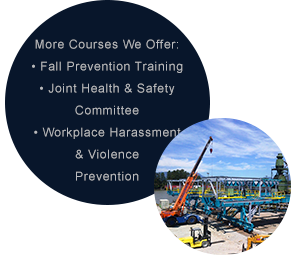The Value of Safety Leadership Courses
Safety leadership is the key to exercising due diligence in the workplace. It promotes the understanding that the well-being of the people you work with is a communal and caring activity that forms the foundation of a safe working environment. Your company needs strong guiding hands at the helm to act as leaders through the ever changing sea of safety laws and standards. You need people in management positions, and on the front lines of your business, that will nurture and grow your organization’s safety culture. This is accomplished through safety leadership training. Here are some of the major benefits of safety leadership training and why it is so vital to your business.
Safety Leadership Drives Home the Understanding that Supervisors are Responsible
When your employees take safety leadership training, it imparts on them that supervisors are responsible for the safety and well being of workers on the job site. Although each employee is ultimately in charge of their own safety, people who are in leadership roles must inculcate a climate of safe work practices. Safety leaders learn to be engaged and active though safety briefings, observing and mentoring workers under their watch, ensuring employees have all required safety equipment, and overcoming safety challenges in a collaborative manner. A competent and fully committed safety leader wouldn’t simply ask an employee to perform a task without first ensuring the worker has the skills and knowledge to complete the job safely. They cheer for the workers success and steer them towards accomplishment. Effective safety leaders are not there to point fingers, but to join hands with everyone in the organization to promote and value safety.
Safety Leadership Gives Employees in Supervisory Roles the Skills to Assess Workplace Risks
Safety leaders should always be keenly aware of the hazards that are present in their workplace. These dangers can vary widely by industry and the type of workplace. Although, no matter where you work, safety leaders need to know how to conduct informal and official job hazard assessments and be able to confidently relay this information to other employees in the company. They possess the initiative to immediately take action and eliminate safety threats that they see in the workplace. These skills help employees become more present and aware of the dangers they and their colleagues face in their industry.
Safety Leadership Teaches Supervisors to be Positive Mentors
You can’t be an effective mentor unless you lead by your own actions. Supervisors are the ultimate champions of safety on a work site, and to be respected safety leaders, they must devote themselves to creating a habit of safety excellence by inspiring other employees around them to embrace their ethics. These rare leaders know how to engage employees with hope, compassion and empathy to increase safety performance. Decreased safety incidents are an indicator that you have great leaders and progress is being made to advance the safety culture across the organization.
Safety Leadership Provides Useful Tools for Giving Feedback
A major contributor to excellent leadership skills is the ability to be an effective communicator. It’s essential that safety leaders learn how to give positive and constructive feedback. They need to know when to praise employees for working safely and how to approach difficult conversations with people about safety incidents should they occur on a work site. Leaders also have the ability to galvanize people to get involved with the safety culture of an organization, encourage each other as members and contributors to a unified workplace community that constantly seeks new knowledge and adopts safe work practices without management direction.
Contact Ship Shape Consulting at (250) 600-6100 to book training for your supervisors where they will learn how to implement the holistic approach to safety and how they fit into the big picture. This is training that will empower them to be safety leaders in your organization.

